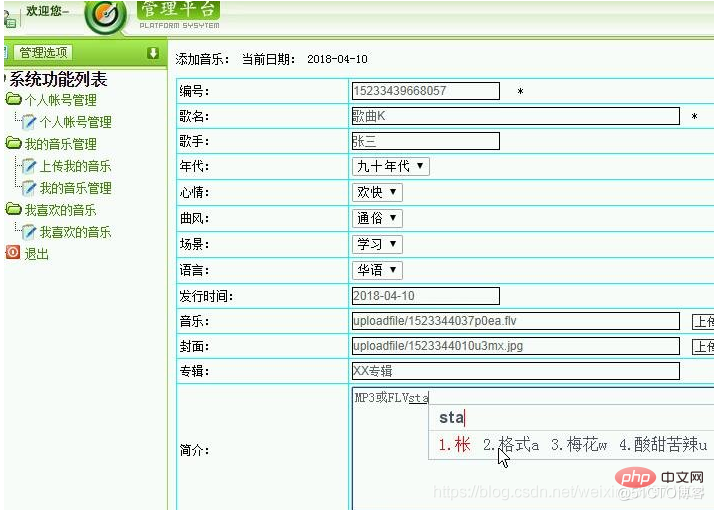
With the increase of Internet users in our country, the development of music players has also been promoted. With the development of network technology, while people are using the Internet to learn, they are also enjoying the effects of various incidental products brought by the network, such as online games and online songs. Music players came into being under the premise of such demand, bringing great fun to people's daily lives, allowing people to relax after busy and tiring work. Based on this current situation, after fully analyzing the market prospects of the industry and investigating user needs, the music player was born.
As the network carrier of music players, music players have had an unprecedented impact on the development of popular music in terms of creation, dissemination, and appreciation methods:
(1) The development of computer network technology has enabled people to play music through The device was exposed to more popular music.
(2) The surge in the number of Internet users has brought more people into contact with popular music through music players.
(3) The music player provides more convenience for popular music creation.
(4) Music players stimulate the spread of popular music.
(5) Music player has changed the way you appreciate popular music.
(6) Music players not only stimulate the spread of popular music, but also stimulate the frequent use of electronic and digital products
1. System login: System login is the gateway for users to access the system. The system login interface is designed, including user name, password and verification code, and then the identity information of the logged-in user is determined to determine whether it is an administrator user or an ordinary user.
2. Page printing: When designing the system, connect the printer in the code to print some pages of the system.
3. Export reports: Users may need to extract some data lists, call the function exported to excel in the code, and enable the driver to connect to excel to realize the function of exporting reports.
4. System user management: Whether you are a super administrator or an ordinary administrator, you need to manage system users, including adding, deleting, modifying, and querying ordinary administrators, modifying the administrator's login password, and newly added administrator users can log in to the system.
5. Registered user management: After visitors register on the front page, they go through the administrator backend. Whether they are super administrators or ordinary administrators, they need to manage registered users, including reviewing, deleting, modifying, and querying registered users. After passing the review, registered users can Log in to the system via account and password.
6. Change password: All users of the system (administrators and registered users) should be able to change their login passwords, and need to log in again after modification.
7. System profile setting: The system administrator should be able to set the system profile information of the system frontend through the system profile setting function. The system profile of the system frontend changes with changes in the backend. The system profile should use an editor to implement pictures, text, lists, Multifunctional input such as styles.
8. System announcement settings: The system administrator should be able to set the system announcement information in the system frontend through the system announcement setting function. The system announcements in the system frontend change with changes in the backend. System announcements should use an editor to implement pictures, text, lists, Multifunctional input such as styles.
9. Add a message: Design a message information table, including message title, message content, reply content, message recipient and other fields. The message title and message content are used to store messages added by users, and the reply content is used to store the message content replied by the administrator.
10. Message management: The system administrator can delete and query the message information table. When replying to messages, the reply content will be stored in the reply content field of the message table, and unnecessary messages will be deleted so that users have enough space to leave messages.
11. Personal information management: Used by registered users. Registered users log in to the personal backend and can modify their original registration information, such as modifying their phone number, email address, etc. The user's user name cannot be modified.
12. Friendly link management: Used by super administrators and ordinary administrators to add, delete, modify, and query all friendly link information in the system. At the same time, the friendly links in the system's front desk are updated as the friendly links in the background change.
13. Music likes: After the administrator publishes music, ordinary users can query the music. The user selects a music to like and jumps to the like form. The user fills in the like form and submits the form to generate a like record. The user queries the personal like record and manages it. The administrator reviews the user's like records. If the review passes, the user likes succeeds; otherwise, the user likes fails.
14. Music management: The user publishes music information, jumps to the music publishing page, fills out the music form, and after submission, the administrator reviews the music information. If the review is successful, the music is successfully displayed in the system front desk.
15. Music playback: The administrator uploads music files, jumps to the music upload page, fills out the form, and selects local music files. After submission, the music is released successfully and users can choose to play or download.
16. Tag information management: Tag information management includes tag information entry, tag information modification, and tag information deletion. The tag information table is designed and established in the database. The administrator adds tag information, that is, inserts a piece of data into the data table, and deletes the tag information. Deleting a piece of data in the database and modifying the label information will modify the data in the database.

Recommended learning: "PHP Video Tutorial"